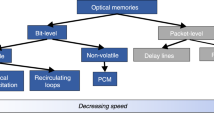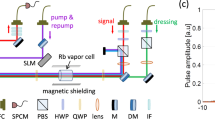Abstract
Optical random-access memory (o-RAM) has been regarded as one of the most difficult challenges in terms of replacing its various functionalities in electronic circuitry with their photonic counterparts. Nevertheless, it constitutes a key device in optical routing and processing. Here, we demonstrate that photonic crystal nanocavities with an ultrasmall buried heterostructure design can solve most of the problems encountered in previous o-RAMs. By taking advantage of the strong confinement of photons and carriers and allowing heat to escape efficiently, we have realized all-optical RAMs with a power consumption of only 30 nW, which is more than 300 times lower than the previous record, and have achieved continuous operation. We have also demonstrated their feasibility in multibit integration. This paves the way for constructing a low-power large-scale o-RAM system that can handle high-bit-rate optical signals.
This is a preview of subscription content, access via your institution
Access options
Subscribe to this journal
Receive 12 print issues and online access
$209.00 per year
only $17.42 per issue
Buy this article
- Purchase on Springer Link
- Instant access to full article PDF
Prices may be subject to local taxes which are calculated during checkout




Similar content being viewed by others
References
Notomi, M. et al. Optical bistable switching action of Si high-Q photonic-crystal nanocavities. Opt. Express 13, 2678–2687 (2005).
Tanabe, T., Notomi, M., Mitsugi, S., Shinya, A. & Kuramochi, E. Fast bistable all-optical switch and memory on a silicon photonic crystal on-chip. Opt. Lett. 30, 2575–2577 (2005).
Soljačić, M., Ibanescu, M., Johnson, S., Fink, Y. & Joannopoulos, J. Optimal bistable switching in nonlinear photonic crystals. Phys. Rev. E 66, 055601 (2002).
Shinya, A. et al. All-optical flip-flop circuit composed of coupled two-port resonant tunneling filter in two-dimensional photonic crystal slab. Opt. Express 14, 1230–1235 (2006).
Kim, M. K., Hwang, I. K., Kim, S. H., Chang, H. J. & Lee, Y. H. All-optical bistable switching in curved microfiber-coupled photonic crystal resonators. Appl. Phys. Lett. 90, 161118 (2007).
Shinya, A. et al. All-optical on-chip bit memory based on ultra high Q InGaAsP photonic crystal. Opt. Express 16, 19382–19387 (2008).
Mori, T., Yamayoshi, Y. & Kawaguchi, H. Low-switching-energy and high-repetition-frequency all-optical flip-flop operations of a polarization bistable vertical-cavity surface-emitting laser. Appl. Phys. Lett. 88, 101102 (2006).
Takeda, K., Kanema, Y., Takenaka, M., Tanemura, T. & Nakano, Y. Polarization-insensitive all-optical flip-flop using tensile-strained multiple quantum wells. IEEE Photon. Technol. Lett. 20, 1851–1853 (2008).
Liu, L. et al. An ultra-small, low-power, all-optical flip-flop memory on a silicon chip. Nature Photon. 4, 182–187 (2010).
Weidner, E., Combrie, S., de Rossi, A., Tran, N. V. Q. & Cassette, S. Nonlinear and bistable behavior of an ultrahigh-Q GaAs photonic crystal nanocavity. Appl. Phys. Lett. 90, 101118 (2007).
Kitayama, K. et al. Optical ram buffer for all-optical packet switches. Proceedings of the Communications and Photonics Conference Exhibition (ACP2009), 1–2 (2009).
Gibbs, H. M. Optical Bistability: Controlling Light with Light (Academic Press, 1985).
Vahala, K. J. Optical microcavities. Nature 424, 839–846 (2003).
Kuramochi, E. et al. Ultrahigh-Q photonic crystal nanocavities realized by the local width modulation of a line defect. Appl. Phys. Lett. 88, 041112 (2006).
Takahashi, Y. et al. High-Q nanocavity with a 2-ns photon lifetime. Opt. Express 15, 17206–17213 (2007).
Notomi, M. et al. Low-power nanophotonic devices based on photonic crystals towards dense photonic network on chip. IET Circ. Device Syst. 5, 84–93 (2011).
Bennett, B. R., Soref, R. A. & Delalamo, J. A. Carrier-induced change in refractive-index of InP, GaAs, and InGaAsP. IEEE J. Quantum Electron. 26, 113–122 (1990).
Tanabe, T., Taniyama, H. & Notomi, M. Carrier diffusion and recombination in photonic crystal nanocavity optical switches. J. Lightwave Technol. 26, 1396–1403 (2008).
Nozaki, K. et al. Sub-femtojoule all-optical switching using a photonic-crystal nanocavity. Nature Photon. 4, 477–483 (2010).
Notomi, M. Manipulating light with strongly modulated photonic crystals. Rep. Progr. Phys. 73, 096501 (2010).
Matsuo, S. et al. High-speed ultracompact buried heterostructure photonic-crystal laser with 13 fJ of energy consumed per bit transmitted. Nature Photon. 4, 648–654 (2010).
Takahashi, R. et al. Photonic random access memory for 40-Gb/s 16-b burst optical packets. IEEE Photon. Technol. Lett. 16, 1185–1187 (2004).
Alparslan, O., Arakawa, S. & Murata, M. Comparison of packet switch architectures and pacing algorithms for very small optical RAM. Int. J. Adv. Internet Technol. 3, 159–169 (2010).
Chen, C. H. et al. All-optical memory based on injection-locking bistability in photonic crystal lasers. Opt. Express 19, 3387–3395 (2011).
Acknowledgements
This work was supported by the National Institute of Information and Communications Technology (NICT). The authors thank T. Tamamura, E. Kuramochi, H. Onji and Y. Shouji for support in fabricating the device, and K. Kitayama, T. Enoki, Y. Hibino, K. Kato, I. Yokohama and Y. Tokura for their continuous encouragement.
Author information
Authors and Affiliations
Contributions
K.N. performed the experiment, analysed the data and wrote the manuscript. A.S. supported the o-RAM design and measurement. S.M., T.S. and Y.K. fabricated the o-RAM samples. Y.S., T.S. and R.T. helped with the demonstration set-up for the parallel o-RAM system. M.N. wrote part of the manuscript and led the project.
Corresponding authors
Ethics declarations
Competing interests
The authors declare no competing financial interests.
Supplementary information
Supplementary information
Supplementary information (PDF 1357 kb)
Rights and permissions
About this article
Cite this article
Nozaki, K., Shinya, A., Matsuo, S. et al. Ultralow-power all-optical RAM based on nanocavities. Nature Photon 6, 248–252 (2012). https://doi.org/10.1038/nphoton.2012.2
Received:
Accepted:
Published:
Issue Date:
DOI: https://doi.org/10.1038/nphoton.2012.2
This article is cited by
-
Comparative analysis of devices working on optical and spintronic based principle
Journal of Optics (2024)
-
An Overview of All-Optical Memories Based on Periodic Structures Used in Integrated Optical Circuits
Silicon (2022)
-
Photonic crystal optical parametric oscillator
Nature Photonics (2021)
-
Global optimization of an encapsulated Si/SiO\(_2\) L3 cavity with a 43 million quality factor
Scientific Reports (2021)
-
Perspective on photonic memristive neuromorphic computing
PhotoniX (2020)



